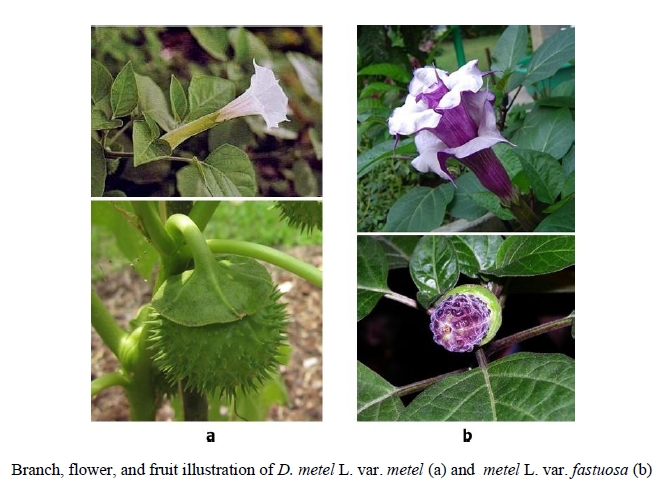การประเมินลักษณะทางจุลทรรศน์อณูโมเลกุลและปริมาณสารสโคโปลามีนของลำโพงขาวและลำโพงกาสลัก
จาก ChulaPedia
การประเมินลักษณะทางจุลทรรศน์ อณูโมเลกุล และ ปริมาณสารสโคโปลามีนของลำโพงขาว และ ลำโพงกาสลัก สมชาย อิสระวาณิชย์, กาญจนา รังษีหิรัญรัตน์ และ นิจศิริ เรืองรังษี วิทยาลัยวิทยาศาสตร์สาธารณสุข จุฬาลงกรณ์มหาวิทยาลัย
ลำโพงขาว และ ลำโพงกาสลักเป็นพืชสมุนไพรในจีนัส Datura ที่พบได้ในเอเชียตะวันออกเฉียงใต้รวมทั้งประเทศไทย การแพทย์แผนโบราณมีการใช้ลำโพงเป็นยาขยายม่านตา และใช้ต้านระบบประสาทพาราซิมพาเธติค มานาน ฤทธิ์ทางเภสัชวิทยาของสารอัลคาลอยด์โทรเปนในต้นลำโพงที่พบในส่วนต่างๆ ของพืชทั้งสอง ได้แก่ ไฮออสซีน (สโคโปลามีน) และ ไฮออสไซยามีน หรือ อะโทรปีน เนื่องจากข้อมูลเกี่ยวกับพืชทั้งสองชนิดมีค่อนข้างจำกัด ดังนั้นวัตถุประสงค์ของการศึกษาวิจัยนี้เพื่อประเมินคุณลักษณะของลำโพงขาว และ ลำโพงกาสลักโดยอาศัยเทคนิคทางจุลทรรศน์ และอณูโมเลกุล รวมทั้งปริมาณสารสโคโปลามีนในพืชทั้งสอง. ผลการประเมินทางมหทรรศน์พบว่าพืชทั้งสองมีสัณฐานวิทยาที่แตกต่างกัน แต่มีคุณลักษณะทางจุลทรรศน์ของภาคตัดขวางลำต้นและเส้นกลางใบที่คล้ายคลึงกัน ค่าคงที่ของใบ (ค่าจำนวนปากใบ ค่าดัชนีปากใบ และค่าอัตราส่วนเซลล์รั้ว) ซึ่งเป็นคุณสมบัติที่สำคัญในการจำแนกชนิดของพืช พบว่ามีความแตกต่างของค่าคงที่ดังกล่าว การเพิ่มปริมาณสารพันธุกรรมในบริเวณ ITS โดยวิธี PCR ได้ผลผลิต PCR ขนาดประมาณ 670 คู่เบส ซึ่งมีความใกล้เคียง 99-100 เปอร์เซ็นต์ โดยพบความแตกต่างของนิวคลีโอไทด์โพลีมอร์ฟิซึม 2 ตำแหน่งในบริเวณ 5.8S และ 4 ตำแหน่งในบริเวณ ITS2 ตำแหน่ง 512 และ 614 ในบริเวณ ITS2 สามารถใช้จำแนกพืชทั้งสองได้ ส่วนการเพิ่มปริมาณสารพันธุกรรมในบริเวณยีน rbcL และ atpB ซึ่งมีขนาด 1.5 กิโลเบส พบว่านิวคลีโอไทด์มีความใกล้เคียง 95-100 และ 94-99 เปอร์เซ็นต์ ตามลำดับ ปริมาณสารสโคโปลามีนในพืชลำโพงทั้งสอง จากการเปรียบเทียบผลระหว่างวิธี TLC image และ HPLC พบว่ามีความสัมพันธ์ของปริมาณสารจากการวิเคราะห์ในทิศทางเดียวกันโดยพบปริมาณสารสโคโปลามีนมากในส่วนดอกในลำโพงขาว และพบมากในส่วนผลของลำโพงกาสลัก. จากข้อมูลดังกล่าว คุณลักษณะทางมหทรรศน์ ค่าคงที่ของใบ และเทคนิคทางอณูโมเลกุลสามารถใช้จำแนกลำโพงทั้งสองที่มีความใกล้เคียงกัน และพืชทั้งสองดังกล่าวมีศักยภาพในการใช้เป็นแหล่งผลิตสารสโคโปลามีน
กิตติกรรมประกาศ: ทุน 90 ปี จุฬาลงกรณ์มหาวิทยาลัย และ ทุนสนับสนุนและส่งเสริมโครงการขับเคลื่อนการวิจัย จุฬาลงกรณ์มหาวิทยาลัย
MICROSCOPIC, MOLECULAR AND SCOPOLAMINE CONTENT EVALUATIONS OF DATURA METEL L. VAR. METEL AND DATURA METEL L. VAR. FASTUOSA SOMCHAI ISSARAVANICH, KANCHANA RUNGSIHIRUNRAT AND NIJSIRI RUANGRUNGSI COLLEDGE OF PUBLIC HEALTH SCIENCESCHULALONGKORN UNIVERSITY
Datura metel L. var. metel and Datura metel L. var. fastuosa (Thai name Lamphong- Khaao and Lam-Phong-Ka-Sa-Lak, respectively) are indigenous herb in genus Datura, that can be found in Southeast Asia, including Thailand. They have a long history of usage in folkloric medicine as parasympatholytic and mydriatic agents. Their pharmacological actions are due to tropane alkaloids, namely hyoscine (scopolamine) and hyoscyamine/atropine, presented in all parts of the plant. Due to the limited data in these medicinal plants, the purpose of this study is to evaluate the characteristics of D. metel L. var. metel and D. metel L. var. fastuosa by microscropic and molecular technique, including their scopolamine contents. According to the results, macroscopic and microscopic analysis of these plants revealed the different morphology and almost similar of stem and midrib cross section. The constant values of leaves (stomatal number, stomata index and palisade ratio), which are the important property for species identification showed different constant numbers. The PCR amplification of ITS region generated the PCR product approximately 670 bp in size, which indicated 99-100% homology. There are two polymorphisms within the 5.8S region, four polymorphisms within the ITS2. The two positions of single nucleotide polymorphism (SNP) were shown at positions 512 and 614 of ITS2 region could be classified these closely related plants.The PCR amplification of rbcL, and atpB region generated the PCR product approximately 1.5 kp in size, which indicated 95-100% and 94-99 % homology, respectively. In this study, the scopolamine contents of two varieties of D. metel L. were compared by TLC image and HPLC method. The comparison of two methods showed good correlation. The results of this study showed the most of scopolamine content in flower part of D. metel L. var. metel, while D. metel L.var. fastuosa showed the most of scopolamine content in fruit part, respectively. According to these evidences, the combinations of macroscopic, constant values of leaves and molecular method are able to authenticate these closely related plants and both of them have a potency to be a source of scopolamine production.
Acknowledgemnts: The 90th Anniversary of Chulalongkorn University Fund (Ratchadaphiseksomphot Endowment Fund), and The Herbal Remedies and Alternative Medicine Task Force of STAR: Special Task Force for Activating Research under 100 Years Chulalongkorn University Fund.


